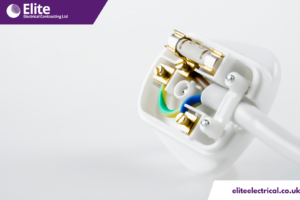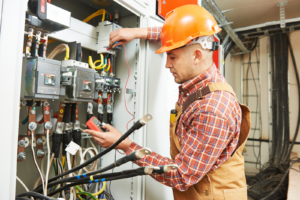Electrical Outfit Installation: Essential Upgrades for Commercial Spaces
In the rapidly evolving landscape of commercial spaces, the need for efficient and reliable electrical systems has never been more critical. Electrical outfit installation refers to the process of upgrading or retrofitting electrical systems in commercial settings, encompassing everything from lighting and outlets to backup power solutions. As businesses expand and technology advances, upgrading these systems becomes essential not only for operational efficiency but also for ensuring safety and compliance with regulatory standards.
The importance of upgrading electrical systems cannot be overstated. Modernising these infrastructures enhances energy efficiency, reduces operational costs, and mitigates the risks associated with outdated components. Furthermore, compliance with local building regulations is paramount, as it ensures that installations meet safety standards and function optimally within the intended environment.
Assessing the Current Electrical System
Before embarking on any upgrade, it is crucial to conduct a comprehensive audit of the existing electrical infrastructure. This assessment serves as the foundation for informed decision-making regarding necessary upgrades and modifications.
Conducting a Comprehensive Audit
A thorough audit involves inspecting all aspects of the electrical system, including wiring, circuit breakers, outlets, and lighting fixtures. This evaluation helps identify any areas that require immediate attention or replacement. Engaging qualified electricians to perform this audit can provide valuable insights into the current state of the electrical system.
Identifying Outdated Components and Potential Safety Hazards
During the audit, it is vital to pinpoint outdated components that may pose safety risks. This includes old wiring that may not meet current safety standards, malfunctioning circuit breakers, or inadequate grounding systems. Identifying these hazards early on can prevent potential accidents and ensure a safer working environment.
Evaluating Power Demands and Capacity Limitations
As businesses grow, their power demands often increase. Evaluating the current capacity of the electrical system is essential to determine whether it can handle additional loads from new equipment or technologies. This assessment will inform decisions regarding necessary upgrades to wiring, circuit breakers, and other components to accommodate future growth.
Planning the Upgrade
Once the assessment is complete, the next step is to plan the upgrade effectively. This phase involves understanding specific business needs and collaborating with professionals to ensure a seamless transition.
Understanding Specific Business Needs and Budget Constraints
Every business has unique requirements when it comes to its electrical systems. Understanding these needs—whether it’s additional outlets for new equipment or enhanced lighting for improved visibility—is crucial in planning an effective upgrade. Additionally, establishing a clear budget will help guide decisions regarding which upgrades are feasible without compromising quality.
Collaborating with Electrical Engineers and Contractors for Strategic Planning
Engaging with experienced electrical engineers and contractors can provide invaluable expertise during the planning phase. These professionals can help design an upgraded system that meets both current needs and future demands while ensuring compliance with all relevant regulations.
Ensuring Compliance with Local Building and Electrical Codes
Compliance with local building codes is non-negotiable when upgrading electrical systems. Understanding these regulations ensures that all installations are safe and legal, helping to avoid costly fines or legal issues down the line. Working closely with professionals who are familiar with local codes can streamline this process significantly.
Key Components of Electrical Outfit Installation
A successful electrical outfit installation involves several key components that must be carefully considered during the planning and execution phases.
Wiring and Cabling: Importance of High-Quality Wiring for Safety and Efficiency
The foundation of any electrical system lies in its wiring. High-quality wiring is essential for safety and efficiency; using cables rated for appropriate voltage levels helps prevent overheating and potential hazards. Upgrading old wiring not only enhances safety but also improves energy efficiency by reducing resistance losses.
Power Distribution: Upgrading Circuit Breakers and Distribution Panels to Handle Increased Loads
As power demands increase, upgrading circuit breakers and distribution panels becomes necessary to manage these loads effectively. Modern circuit breakers offer advanced features such as overload protection and remote monitoring capabilities, ensuring that the system operates safely under varying conditions.
Lighting Systems: Installing Energy-Efficient Lighting Solutions
Lighting plays a significant role in any commercial space. Installing energy-efficient lighting solutions, such as LED systems, not only reduces energy consumption but also lowers operational costs over time. Additionally, incorporating emergency lighting ensures compliance with safety regulations while providing peace of mind during unexpected power outages.
Backup Power Solutions: Implementing Generators and Uninterruptible Power Supplies (UPS)
In today’s fast-paced business environment, reliability is paramount. Implementing backup power solutions like generators and uninterruptible power supplies (UPS) safeguards against unexpected outages, ensuring that critical operations can continue uninterrupted. These solutions are particularly important for businesses that rely heavily on technology or have specific uptime requirements.
Safety Standards and Compliance
When undertaking electrical outfit installations, adherence to safety standards and compliance with local regulations is paramount. These measures not only protect the installation team but also ensure the safety of building occupants and the integrity of the electrical systems.
Overview of Local Building Codes and Safety Regulations
Electrical installations in commercial settings must comply with a variety of local building codes and safety regulations. These codes are established to ensure that electrical systems are safe, reliable, and efficient. They typically cover aspects such as wiring methods, circuit protection, grounding requirements, and installation practices. Familiarity with the National Electrical Code (NEC) and other relevant standards is essential for anyone involved in electrical installations. Compliance with these regulations helps prevent accidents, legal liabilities, and costly fines.
In addition to national standards, local regulations may impose additional requirements based on specific regional risks or historical incidents. Therefore, it is crucial to consult with local authorities or licensed professionals to ensure that all installations meet the necessary compliance standards.

Essential Safety Practices During Installation
Safety practices during installation are vital to mitigate risks associated with electrical work. Key safety measures include:
- Using Personal Protective Equipment (PPE): Installation teams should always wear appropriate PPE, such as insulated gloves, safety glasses, hard hats, and non-conductive footwear. This equipment provides essential protection against electrical shocks and other hazards.
- Ensuring Proper Grounding: Grounding is critical for protecting both people and equipment from electrical faults. All installations must include adequate grounding systems that comply with relevant codes to ensure safety during operation.
- Lockout/Tagout Procedures: Implementing lockout/tagout procedures helps prevent accidental energisation of electrical circuits during maintenance or installation work. This practice ensures that only authorised personnel can access live circuits.
Installation Process
The installation process is where planning translates into action. It involves meticulous attention to detail and strict adherence to safety protocols to ensure a successful and safe installation.
Execution: Step-by-Step Installation
The execution phase involves a systematic approach to installing the electrical system. This includes:
- Installing the Main Electrical Panel: The main panel serves as the central hub for power distribution throughout the building.
- Running Wiring Throughout the Building: Following pre-planned routes while securing cables properly to prevent damage.
- Installing Circuit Breakers, Outlets, and Switches: Positioning these components in their designated locations according to the layout plan.
- Setting Up Lighting Systems: Installing various lighting fixtures, including energy-efficient options like LED lights.
- Connecting Specialised Systems: This may include data cabling or other technology-specific installations as required by the business.
Safety Protocols: Adhering to Safety Standards
Throughout the installation process, adherence to safety protocols is crucial. This includes conducting regular safety audits, ensuring that work areas are well-lit and free from obstructions, clearly labelling all circuits and switches, and following manufacturer instructions for all equipment used. Regular inspections during installation can help identify potential hazards early on.
Testing and Commissioning
Once installation is complete, thorough testing of the entire electrical system is essential to ensure functionality and compliance with safety standards.
Conducting Thorough Testing Post-Installation
Testing involves checking each component of the system for proper functionality. This includes verifying that all circuit breakers operate correctly, outlets provide power as intended, and lighting systems illuminate effectively. Any discrepancies should be addressed immediately before finalising the installation.
Ensuring All Components Function Correctly
It is vital to ensure that all components meet safety standards set forth by local regulations. This may involve using specialised testing equipment to measure voltage levels, current loads, and grounding effectiveness.
Documenting the Installation Process for Future Reference
Documenting each step of the installation process is critical for future maintenance and troubleshooting. This documentation should include details about materials used, circuit layouts, testing results, and any issues encountered during installation.
Post-Installation Maintenance
Regular maintenance is essential for ensuring long-term reliability of electrical systems in commercial settings.
Importance of Regular Inspections and Maintenance
Scheduling routine inspections allows for early identification of wear and tear on components such as wiring or circuit breakers. Regular checks can prevent potential hazards from developing into serious issues that could disrupt operations or pose safety risks.
Addressing Potential Issues Early
Proactive maintenance helps address potential problems before they escalate into costly downtime or hazards. Keeping a detailed log of maintenance activities can aid in identifying patterns or recurring issues that may require further attention.
Troubleshooting Common Issues
Even with careful planning and execution, common issues may arise post-installation that require troubleshooting:
- Frequent Circuit Breaker Trips: This may indicate an overloaded circuit or faulty wiring.
- Flickering Lights: Often caused by loose connections or inadequate wiring.
- Unresponsive Outlets: These could result from faulty outlets or tripped breakers requiring inspection.

Guidance on How to Address These Issues Effectively
For each issue identified, it is important to follow a systematic troubleshooting approach:
- Identify symptoms.
- Check relevant connections or components.
- Test circuits for continuity.
- Replace faulty parts as necessary.
Expertise and Professional Help
Hiring qualified electricians for complex installations cannot be overstated. Their expertise ensures compliance with all relevant regulations while providing peace of mind regarding safety standards.
When selecting a contractor for electrical outfit installations:
- Look for licensed professionals with experience in commercial settings.
- Verify their credentials and past project success.
- Ensure they have adequate insurance coverage for liability protection.
By engaging experienced professionals like Elite Electrical—established in 1999 with over 20 years of experience in commercial fit-out services—you can ensure your electrical systems are installed safely and efficiently while adhering to industry best practices.
Conclusion
In conclusion, electrical outfit installations are a vital aspect of modernising commercial spaces, ensuring they are safe, efficient, and compliant with current regulations. By assessing existing systems, planning upgrades strategically, and adhering to safety standards throughout the installation process, businesses can create environments that not only meet their immediate needs but also accommodate future growth and technological advancements.
Take the Next Step Towards a Safer, More Efficient Workspace!
Are you ready to elevate your commercial space with a top-tier electrical outfit installation? Contact Elite Electrical today to discuss your project needs and discover how our dedicated team can provide tailored solutions that ensure safety, efficiency, and compliance.
Contact Us:
- Address: 30 Upper Mulgrave Road, Sutton, Surrey, SM2 7BD
- Phone: 020 8644 3200
- Email: [email protected]







